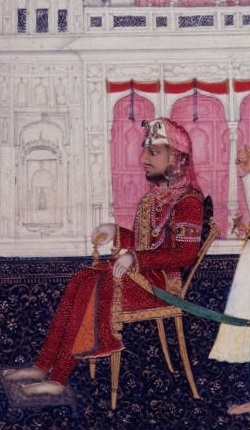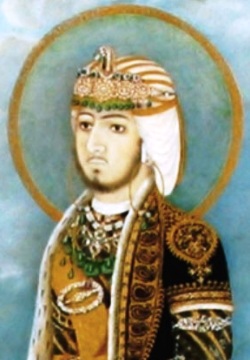NABHA

The Phulkian Dynasty
GENEALOGY
- 1) Mian Suratiya Singh, educ. privately. He d.v.p. at Fort Dhanaula, before 3rd April 1753, having had issue, two sons:
- a) Sardar Kapur Singh, of Kapurgarh and Sangrur, educ. privately. m. Sadarni Raj Kaur (m. second, 1775, her brother-in-law, Sardar Hamir Singh Sahib, Rais-i-Azam of Nabha - see below), daughter of Sardar Sujan Singh Mansahia. He d.s.p. before 19th March 1776.
- b) Sardar Hamir Singh, Rais-i-Azam of Nabha – see below.
- 1) Kunwar Jaswant Ranjit Singh, Tikka Sahib, who succeeded as Barar Bans Sarmur, Raja Jaswant Singh, Malvendra Bahadur, Raja of Nabha (s/o Raj Kaur) – see below.
- 2) Kunwar Makhan Singh Sahib.
- 1) Bibiji Subha Kaur Sahiba [Rani Mai Subha Kaur] (d/o Desu Kaur). Succeeded her husband in the Mowran estates 1815, which she later exchanged for Zahura and Manokah. m. at the Fort, Nabha, 1806, as his second wife, Sardar Sahib Singh Bhangi (d. 1815), of Mowran, in the Gujrat district of Punjab. She d. at Manokah, April 1839.
- 2) Bibiji Sada Kaur Sahiba [Sardarni Sada Kaur] (d/o Desu Kaur). m. as his first wife, Sardar Jai Singh Kanhaiya (b. 1712; d. 1793), elder son of Khushal Singh, a Jat cultivator.

- 1) Kunwar Ranjit Singh, Tikka Sahib. b. at the Fort, Nabha, before 3rd April 1791 (s/o Daya Kaur), educ. privately. Proclaimed as Heir Apparent with the title of Tikka Sahib, at his birth, 1791. Rebelled against his father in 1818, then reconciled, but charged with conspiracy again in 1822 and 1824. m. (first) a daughter of Sardar Jodh Singh, of Bamne-Kaleki. m. (second) a daughter of Sardar Jassa Singh, of Shahpur. m. (third) at Patriri, 1831, a daughter of Sardar Daya Singh Bhamna. He d.v.p. at Patriri, 17th June 1832, having had issue, an only son:
- a) Kunwar Santokh Singh. m. Kunwarani Bhagbari Sahiba, daughter of Sardar Sher Singh, of Shahabad. He d.v.p. suddenly, at Nabha, before 16th September 1830.
- 2) Kunwar Devendra Ranjit Singh, Tikka Sahib, who succeeded as Barar Bans Sarmur, Raja Sri Devendra Singh, Malvendra Bahadur, Raja of Nabha (s/o Har Kaur) – see below.
- 3) Kunwar Kahan Singh Sahib, educ. privately. He d.v.p.s.p.

- 1) Kunwar Bharpur Ranjit Singh, Tikka Sahib, who succeeded as H.H. Farzand-i-Arjumand, Aqidat-Paiwand-i-Daulat-i-Inglishia, Barar Bans Sarmur, Raja Sri Bharpur Singh, Malvendra Bahadur, Raja of Nabha (s/o Man Kaur) – see below.
- 2) Kunwar Bhagwan Ranjit Singh, Tikka Sahib, who succeeded as H.H. Farzand-i-Arjumand, Aqidat-Paiwand-i-Daulat-i-Inglishia, Barar Bans Sarmur, Raja Sri Bhagwan Singh Malvendra Bahadur, Raja of Nabha (s/o Man Kaur) – see below.
- 3) A s/o Rani Lilavati who d. in childbirth.


Copyright© Christopher Buyers, September 2006 – December 2024